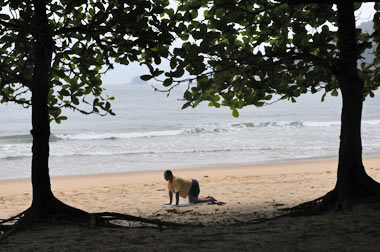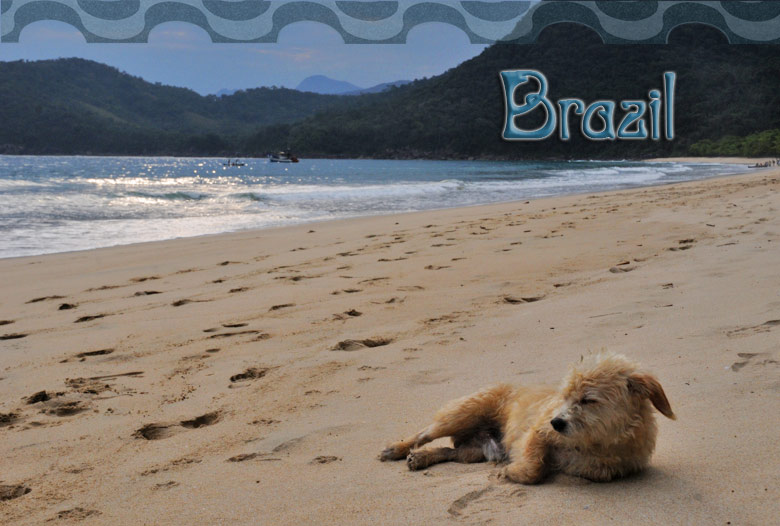
Bélu on Praia do Sono
Beyond the City
We wanted to see more of Brazil than just Rio, but without a car ... how? Fortunately we found Rio Hiking, a company that did excursions in and around the city. When we saw that they had a two-day trip to the village of Parati, about 200 miles down the coast, we were on board.
Our guide Bruno picked us up bright and early and we were off ... sort of. Just getting outside of the city, a sprawling urban area during the morning commute took some doing. We were fascinated by the size of the city and outskirts and at how people (thousands/millions? on buses) got to work everyday. (The population of the Rio metropolitan area is 10.5 million.) Bruno, a Rio native who learned English in Australia, was also a lawyer and entrepreneur and a great source of information. And for two days we peppered him with all kinds of questions about Brazil, from the environment to Giselle Bundchen.
Much of the trip was along the Green Coast, where hundreds of islands were just offshore and the forest goes right to the sea, as Bruno put it. It was a very circuitous drive around bays and mountains with villages built next to and up the slopes. When we arrived in Parati (par-ah-CHEE), we stopped at a grocery for a few snacks (and dog treats — we'd just seen a stray on the street) and then continued south. We ended up in a small community, parked the car and set off on foot. We weren't sure what was ahead, we just knew we'd been staying at a cabin on a beach.
 Bruno and the nice lady whose yard we parked in. |
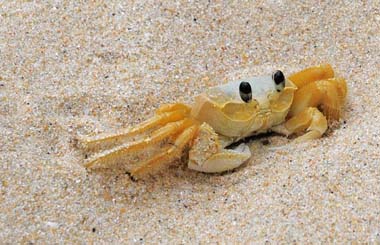 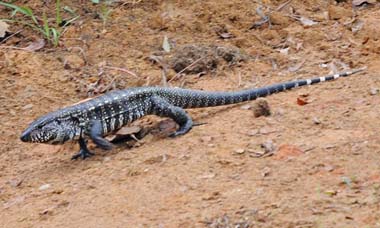 Creatures on our path. |
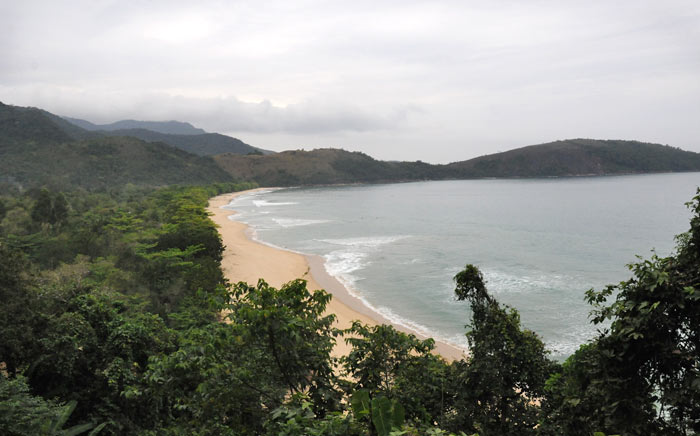 Our first look at Praia do Sono. |
|
We hiked through a dense forest (Peter said that that sounds like we hacked through the jungle with a machete. So, to be clear, we were on a wide-open path in the deep dark woods), up and over a mountainside until we came to a remote beach, Praia do Sono (Sleepy Beach). There was a small village of about 70 people and just a couple small guest cabins that one of the residents ran. It was peaceful, beautiful and unexpected — we became part of the community for a short time. And I found a new friend, Bélu, a cute terrier who greeted us when we arrived. After putting our stuff in the cabin we took another hike over the mountain on the opposite side of the beach.
![]() We met a few of the villagers, but only one spoke English. Emily was a teacher whose mother was English. She had married Favio, moved to the beach and had a family with him. She seemed very content with the simple life they had, but was very excited because the school had just gotten an Internet connection. She explained that there had been proposals to bring electricity to the beach, but nothing had been done, generators provided the only power. The village had a school, a church and around 30 houses, though there may have been more hidden by the forest further inland.
We met a few of the villagers, but only one spoke English. Emily was a teacher whose mother was English. She had married Favio, moved to the beach and had a family with him. She seemed very content with the simple life they had, but was very excited because the school had just gotten an Internet connection. She explained that there had been proposals to bring electricity to the beach, but nothing had been done, generators provided the only power. The village had a school, a church and around 30 houses, though there may have been more hidden by the forest further inland.
Later, after a nice dinner of fresh fish in the outdoor "restaurant", Bruno said, "There's good news and bad news. The good news is, the generators are on from 6:00 to 10:00; the bad news is, there's no hot water." Well now. Going without a shower after all the hiking wasn't an option, so on a cool night under cold water, I gritted my teeth, got clean, then used the light while available to read my book. See Praia do Sono photos.
Bruno took us on another hike in the morning, this one about a half hour inland. We walked down a village path lined with simple houses, dogs and chickens. We met the priest, a very friendly man who had a lot to say to us in Portugese. We arrived at a small waterfall, our destination. (See the waterfall video.) While resting there, I looked up and was excited to see an unusual bird perched above the falls. I found out later (thanks to the always-reliable Birdforum members) that it was a white-tailed trojon. So I was happy, though still longed to see a toucan. Ever since eating Froot Loops as a kid, I've been fascinated with them. I hope someday I'll see a real Toucan Sam in the wild.
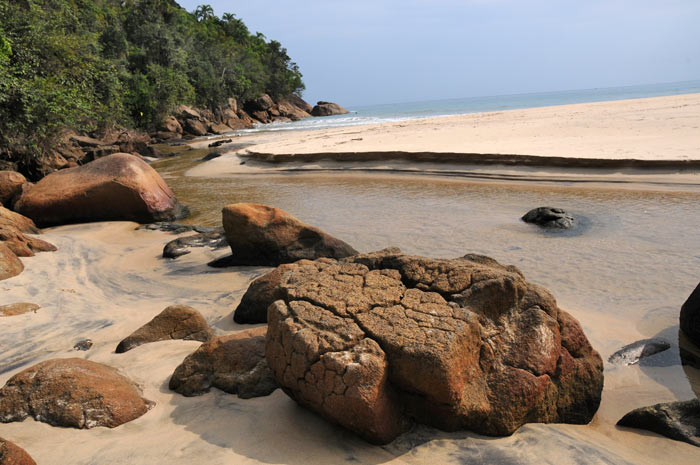 River to the ocean. |
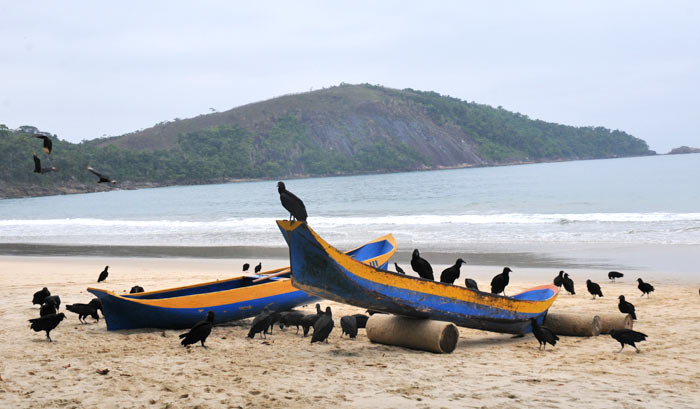 Black vultures love the morning catch routine. |
Favio had Emily ready to go when we returned; we were leaving the beach by sea. He pushed us out after catching just the right tide level and we were off, rounding the mountainside we had hiked to get there. The water color was an irridescent turquoise that seemed to be lit from below. We rode some large swells in the small boat, the fun kind. We saw two young Magellanic penguins on the way, they were far north of their normal range and seemed lost and tired ... very sad. But later I found out that many had been rescued, hooray.
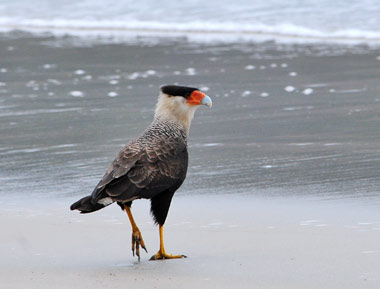 A southern caracara! |
|
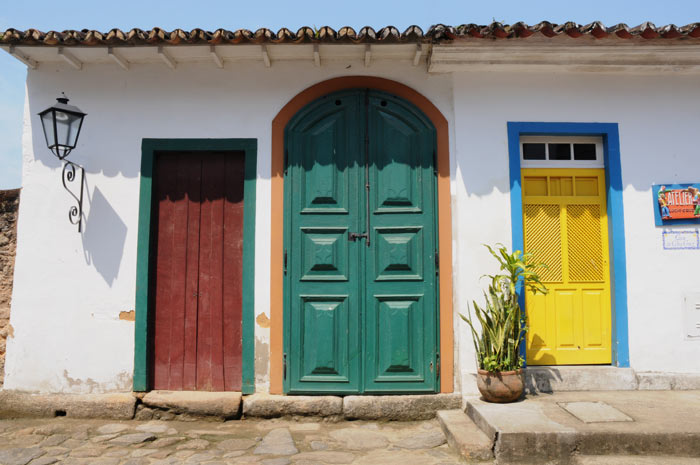 A typical facade in Paraty. |
|
Our next stop was the colonial village of Paraty. Bruno dropped us off to walk around on our own for a couple hours. It's like a fairy tale setting come to life, full of bright colorful facades and cobblestoned streets. It was founded by Portugese explorers in 1667, and the world's richest gold mines were discovered soon after in the mountains of nearby Minas Gerais. ![]() So Paraty became a key exporting center for gold going back to Portugal and up the coast to Rio. But the gold ran out after about 100 years and Paraty had to find another product to move. Luckily, the conditions were perfect to grow coffee so that was the port's salvation. But a new railroad to Rio put an end to Paraty's port business. It stayed isolated for a long time with no roads going in or out, and its architecture stood still in time. See Paraty photos.
So Paraty became a key exporting center for gold going back to Portugal and up the coast to Rio. But the gold ran out after about 100 years and Paraty had to find another product to move. Luckily, the conditions were perfect to grow coffee so that was the port's salvation. But a new railroad to Rio put an end to Paraty's port business. It stayed isolated for a long time with no roads going in or out, and its architecture stood still in time. See Paraty photos.
Now tourism is Paraty's main business, though we didn't see much activity when we were there. No cars were allowed in the village center, so we walked around on mostly quiet, empty streets. We found all four of the baroque churches in town, each unique but also similar. Along the waterfront we could see evidence of Paraty's strange street-cleaning method. The streets in the historic district were designed to be flooded by the sea once a month during the full moon and a high tide. So up to ten inches of water cover the streets until the tide goes out. Paraty was unlike any place I'd ever been, and was a photographer's dream ... I wish we'd had more time.
We arrived back in the city during the evening rush hour. If you think you've got a tough commute, try getting around Rio's traffic-snarled streets and highways. Bruno had local knowledge and good reflexes so we got back to the hotel alive. It had been an unforgettable excursion ... obrigada, Bruno!
 A massive electrical junction in Rocinha favela. |
A Different Side of Rio
Another thing I was really wanted to do in Rio was visit a favela. They are the hillside "slum" neighborhoods where the poorer residents of Rio live. I found Marcelo Armstrong's favela tours online and we firmed up a date once in Brazil. ![]() We got in an old van with a driver, our guide Simone and seven others for a half-day tour. The favelas we visited were on the south side of Rio, but there are over 700 favelas spread all over, with over one million residents, Simone told us. And that was just an estimate as the population continues to grow.
We got in an old van with a driver, our guide Simone and seven others for a half-day tour. The favelas we visited were on the south side of Rio, but there are over 700 favelas spread all over, with over one million residents, Simone told us. And that was just an estimate as the population continues to grow.
The first favela came about over 100 years ago, when Brazilian war veterans came to Rio to collect the homes they were promised for their service. They camped out on a hillside, and when the government failed to deliver, ended up building their own community.
Our first stop was at a relatively small favela, Vila Canoas. It is one of the fortunate favelas, with a community school (partly funded by the tours). It was nice to see all the happy kids at the school. We were able to walk through the maze of narrow hallways that connect and thread through the individual compartments staggered up the hill, one partly on top of another. From the look of it you'd think it could all come tumbling down at any time. But most of the men in the favela communities are construction workers. So despite the ramshackle appearance, the structures are soundly built. See the Favela photos.
We also visted Rocinha, the largest favela in Rio with over 150,000 inhabitants — reallly a city within a city. It has its own TV and radio stations, newspapers, banks and many other businesses. It was an intense, bustling environment. We walked the streets taking in the cacophony of sights, sounds and smells ... and heeded Simone's warning not to photograph in the direction of the drug dealers as we passed by them. There is a unique arrangement in that regard. ![]() The Rio police stay outside of the favela, not interfering with the drug business, provided the dealers maintain order and handle crime within. Apparently this works to everyone's satisfaction.
The Rio police stay outside of the favela, not interfering with the drug business, provided the dealers maintain order and handle crime within. Apparently this works to everyone's satisfaction.
It was fascinating to get some idea of how life is lived within the favelas. As Lonely Planet put it: "Favelas exhale cultural vitality." I could feel it. We bought a couple items from local artists, including a CD from musician Ivson Lins. Listen to a little mood music — I love the feel of this song.
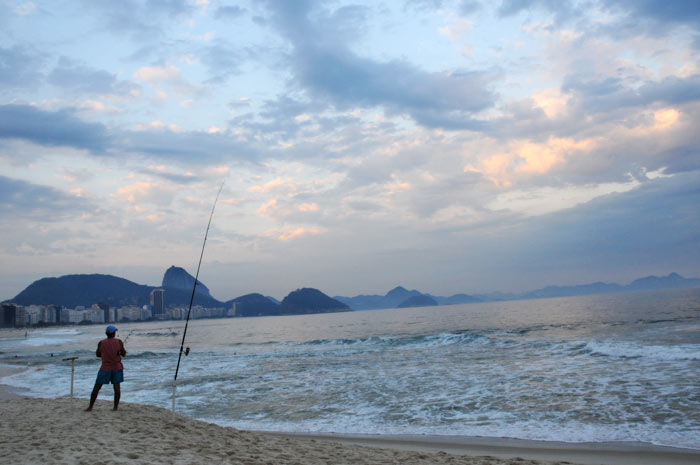 |
We spent a little more time exploring locally before it was time to leave. See Final Rio photos. The trip home was long but safe. Reliving it all while creating this story has only reinforced what an amazing, enriching experience Brazil had been. And no dengue fever! The figa delivered in a big way.
© 2008 CCarnovale
Home
| Web Design | Graphics
| Photos | Travels
| At
Home | Bird Index
carole@randomviews.com
